Publications

October 16, 2025
This report summarizes key themes that emerged from the 2025 Financial Innovations Roundtable (FIR). FIR has long served as a forum for creating cross-sector partnerships to expand access to capital in low-income communities. This year’s convening focused on the challenge of developing and preserving housing that is affordable to low- and moderate-income residents without direct federal subsidies…

September 10, 2025
In this working paper, authors Michael Swack and Sara Razavi discuss merger, acquisition, and other forms of integration to fulfill the CDFI mission more effectively, efficiently, and expeditiously to stem the widening wealth gap.
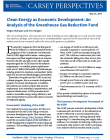
May 12, 2025
In this perspectives brief, authors Megan Mahajan and Eric Hangen discuss new analysis by Energy Innovation that has now estimated how far the Greenhouse Gas Reduction Fund will go toward its economic development goals.
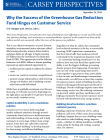
September 24, 2024
In this perspectives brief, authors Eric Hangen and Jessica Luk-Li stress that while there is justifiable excitement over the new
GGRF financing, success in deploying it to the right places and people will only happen if those involved get laser-focused on two words: customer service.
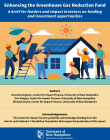
June 27, 2024
In this brief, authors Hannah Vargason, Eric Hangen, and Michael Swack discuss the ways foundations and other catalytic capital investors can fill gaps in and support the effective and equitable implementation of the EPA’s Greenhouse Gas Reduction Fund.
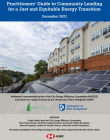
December 15, 2023
In this guide, authors Curtis Probst, Tina Poole Johnson, and Hannah Vargason share a collection of key resources and references that provide an entry point to clean energy finance for community lending practitioners and to community development finance for green lenders.
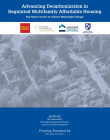
August 2, 2023
The policy levers contained in this working paper outline a series of steps that can be taken to advance decarbonization today, create sustainable systems change, and climate align housing for our future.
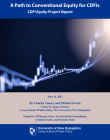
June 26, 2023
In this report designed to serve the Community Development Financial Institution (CDFI) sector, authors Charles Tansey and Michael Swack describe a step-by-step blueprint for accessing private equity in Stage One and conventional equity in the public market in Stage Two through participating CDFIs.
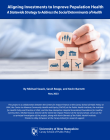
May 15, 2023
In this report, authors Michael Swack, Sarah Boege, and Kevin Barnett discuss the initiative to develop a statewide strategy to address the social determinants of health in New Hampshire.
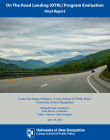
April 19, 2023
In this report, Michael Swack, Jolan Rivera, and Sanjeev Sharma discuss the results of the On The Road Lending program evaluation.
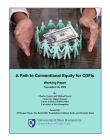
November 16, 2022
In this working paper, authors Charles Tansey and Michael Swack outline a path to conventional equity for CDFIs.
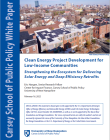
February 16, 2022
Scaling clean energy in low-income communities through solar and deep efficiency retrofits presents financing challenges, but that is only part of the problem. Drawing on research conducted by the Carsey School’s Center for Impact Finance, this white paper outlines a road map depicting the ecosystem needed to deliver clean energy projects to underserved communities.
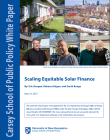
May 19, 2021
The U.S. solar photovoltaics industry has taken off over the past decade, but without deliberate action low- and moderate-income communities could be left behind in the transition to clean energy. Drawing on substantial literature related to multiple dimensions of low-income solar finance and interviews with key informants in the field, authors Eric Hangen, Rebecca Regan, and Sarah Boege…
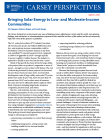
April 23, 2021
The U.S. solar photovoltaics industry has taken off over the past decade, but without deliberate action low- and moderate-income communities could be left behind.
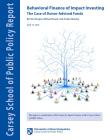
April 14, 2020
Donor-advised funds present a unique opportunity to promote impact investing into the local community, including Community Development Financial Institutions that serve their local communities.
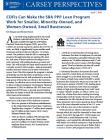
April 7, 2020
As currently being implemented by the Small Business Administration, the loans made available through the $349 billion Paycheck Protection Program, part of the CARES Act recently enacted to address the COVID-19 crisis, are likely to significantly bypass smaller small businesses and those that are minority- or women-owned.
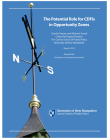
March 27, 2019
The Opportunity Zones legislation was designed to mobilize new levels of capital into low- and moderate-income (LMI) communities – areas that have historically been overlooked and underserved by mainstream capital markets. As longstanding financial partners to LMI communities, Community Development Financial Institutions (CDFIs), it would seem, are positioned to play a pivotal role in the…
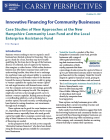
October 31, 2017
Business owners seeking to start or expand a small business have limited options for financing. They can go to a bank for a loan, but they may have trouble qualifying for the loan due to the age of the business, absence of collateral, lack of equity in the business, thin margins, or other factors. While online business lenders may offer faster response times and lower underwriting hurdles, they…
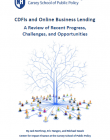
November 10, 2016
In March 2015, the Center for Impact Finance at the Carsey School of Public Policy at the University of New Hampshire convened the 16th Annual Financial Innovations Roundtable at the Federal Reserve Board in Washington, DC.
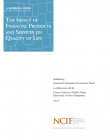
February 3, 2016
http://ncif.org/sites/default/files/free-publications/The%20Impact%20of%20Fin%20Products%20and%20Services%20on%20QOL%20-%20Secured.pdf
